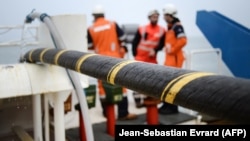Announcing fresh sanctions against Russia this week, the U.S. Treasury Department accused Moscow of "tracking undersea communications cables" and imposed punitive measures on a St. Petersburg firm that it says provided underwater diving equipment to Russia's Federal Security Service (FSB).
The announcement followed warnings by U.S. and other Western officials about Russian activities in recent years near undersea cables that serve as conduits for nearly all global telecommunications data.
"We are now seeing Russian underwater activity in the vicinity of undersea cables that I don't believe we have ever seen," U.S. Navy Rear Admiral Andrew Lennon, the commander of NATO's submarine forces, told The Washington Post in December.
Britain's military chief, Sir Stuart Peach, said in December that Russia could pose a major threat to NATO by attacking undersea cables critical for international trade and the Internet. He warned that economies could be hit "immediately and potentially catastrophically" if the cables were severed or otherwise disrupted.
But just how vulnerable is this network of cables, known as the "backbone of the global Internet," to sabotage and other manipulation?
The location of cables -- which are roughly the diameter of a garden hose -- along the ocean floor offers a modicum of security from actors who would intentionally try to damage them.
"It's not that it's much more difficult to sever cables in the deep ocean, it's just that the primary forms of interference are less likely to happen," writes Nicole Starosielski, an associate professor at New York University and author of the 2015 book The Undersea Network.
"The sea is so big and the cables are so narrow, the probability isn't that high that you'd run across one," Starosielski adds.
Experts say that the multiple paths for telecommunications traffic via the cables also offer security: If a single cable were broken, in most cases that traffic would be rerouted around different parts of the network.
Anchors, Fishing Gear, And…Sharks?
As of early 2018, there were an estimated 448 submarine cables -- totaling more than 1 million kilometers in length -- operating throughout the world, according to TeleGeography, a Washington-based market research firm.
This network, however, includes so-called "chokepoints" where crucial cable routes converge, according to a 2010 study by the Institute of Electrical and Electronics Engineers and the EastWest Institute think tank.
"A single disaster in such an area could cause catastrophic loss of regional and global connectivity," the report said.
Starosielski told Wired last month, however, that "the amount of anxiety about somebody sabotaging a single cable or multiple cables is overblown."
"If somebody knew how these systems worked and if they staged an attack in the right way, then they could disrupt the entire system. But the likelihood of that happening is very small. Most of the concerns and fears are not nearly a threat at all," she said.
Undersea cables are, in fact, damaged regularly, with experts estimating between 100 and 200 such incidents each year. Two of the main causes are less exotic than state sabotage; namely, anchors dragging across the seabed and fishing gear that gets tangled up with the cables, experts say.
There have been incidents of sharks biting deep-sea fiber-optic cables, though the Britain-based International Cable Protection Committee (ICPC) recorded no such incident between 2007 and 2014.
In 2013, the Egyptian coast guard arrested three divers who authorities said were cutting through a cable near Alexandria, though officials did not indicate a motive.
Almost all undersea cables are privately owned, and the ICPC -- which has more than 170 members from more than 60 countries -- has called for action by governments around the world to safeguard the deep-ocean networks.
Deep-Sea Espionage
Undersea cables have also been targeted for surveillance purposes.
The United States tapped Soviet cables in the Sea of Okhotsk during the Cold War, and documents leaked by former U.S. National Security Agency (NSA) contractor Edward Snowden indicated that U.S. and British intelligence had gained access to data transmitted in undersea cables.
In September 2015, the United States monitored the Russian research vessel Yantar as it traveled to Cuba along the U.S. East Coast. The New York Times cited U.S. Navy officials as saying that it carried submersible crafts capable of diving and cutting undersea cables.
An official Russian government publication has openly discussed Yantar's surveillance capabilities.
"Yantar has devices aboard intended for deep-sea tracking, as well as equipment for connecting to top-secret communications cables," the official newspaper of the Russian parliament wrote in October.
The U.S. Treasury Department, which identified the St. Petersburg underwater equipment company as Divetechnoservice, did not explicitly specify any connection between it and the Yantar Baltic Shipyard, which built the Yantar research vessel.
However, Russian government procurement documents, as well as arbitration records, show that Divetechnoservice signed contracts in 2012 with the shipyard to produce and test a one- and two-man deep-water submersible capable of operating at depths up to 1,000 meters (3,000 feet). And the company's website includes photographs of the submersible crafts.













